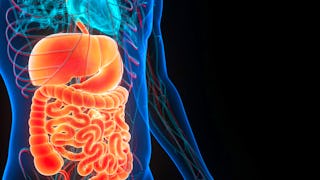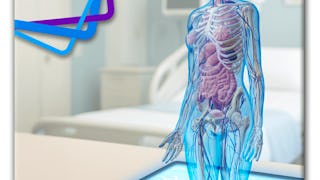This course examines how the digestive system processes food, absorbs nutrients, and eliminates waste.


Digestive Dynamics: Understanding the GI System
This course is part of Interactive 3D Anatomy & Physiology: A Gamified Experience Specialization



Instructors: Hilary Gupte
Access provided by Coursera Learning Team
Recommended experience
What you'll learn
Learners will explore the functions of key digestive organs and their role in metabolism
Learners will understand how the body absorbs nutrients and eliminates waste
Learners will apply digestive system knowledge to case studies, such as GERD and IBS
Details to know

Add to your LinkedIn profile
15 assignments
March 2025
See how employees at top companies are mastering in-demand skills

Build your subject-matter expertise
- Learn new concepts from industry experts
- Gain a foundational understanding of a subject or tool
- Develop job-relevant skills with hands-on projects
- Earn a shareable career certificate


Earn a career certificate
Add this credential to your LinkedIn profile, resume, or CV
Share it on social media and in your performance review

There are 4 modules in this course
This lesson introduces learners to the upper gastrointestinal (GI) tract, emphasizing its critical role in the digestive process. Students will explore the structure and function of the oral cavity, esophagus, and their associated components. Through a detailed overview, learners will gain insight into the initial stages of digestion, including mechanical and chemical processes, and understand how food is prepared for further breakdown in the stomach.
What's included
4 videos1 reading5 assignments
This lesson focuses on the anatomy and functions of the stomach and its role in the digestive process, as well as the structural support provided by the peritoneum and mesenteries. Learners will explore the regions of the stomach, their specialized roles in digestion, and the interaction between mechanical and chemical processes that break down food. Additionally, the lesson covers the peritoneum and mesenteries, highlighting their importance in supporting and connecting abdominal organs within the digestive system.
What's included
4 videos1 reading5 assignments
In this lesson, learners explored the role of sphincters and intestines in the gastrointestinal system. The importance of sphincters in regulating the movement of food and materials throughout the digestive tract was highlighted, emphasizing their role in preventing backflow and ensuring proper digestion. The structure and functions of the small intestine were detailed, with a focus on its sections, the duodenum, jejunum, and ileum, and their contributions to nutrient absorption. Finally, learners examined the large intestine, understanding its role in water absorption, waste formation, and the significant contribution of gut microbiota to overall digestive health.
What's included
4 videos1 reading5 assignments
This lesson explores the causes, symptoms, and management of common gastrointestinal (GI) disorders, including GERD, peptic ulcers, IBS, IBD, and colorectal cancer. By examining these conditions through real-world case studies, learners will gain an understanding of how disruptions in the GI system affect digestion, nutrient absorption, and overall health. The lesson emphasizes the importance of early diagnosis, lifestyle adjustments, and medical interventions in managing these disorders and maintaining GI health.
What's included
5 videos
Offered by
Why people choose Coursera for their career




Recommended if you're interested in Health

Rice University

University of California, Davis

Open new doors with Coursera Plus
Unlimited access to 10,000+ world-class courses, hands-on projects, and job-ready certificate programs - all included in your subscription
Advance your career with an online degree
Earn a degree from world-class universities - 100% online
Join over 3,400 global companies that choose Coursera for Business
Upskill your employees to excel in the digital economy



